AOC i2353Ph - IPS for a nice, low price
by Chris Heinonen on January 30, 2012 12:40 AM ESTCalibration and Results
Of course, once we use ColorEyes Display Pro to calibrate the AOC, we would expect even better results than we got out of the box. As usual, we set a white point target of D65, a gamma of 2.2, minimum black level, and a white level of 200 nits. I then checked the quality of the calibration using the Gretag Macbeth color checker chart. Often you will see display reviews that use the calibration target points to see the quality of the calibration. That gives you a good indicator of how well the software and hardware was able to hit those targets, but unfortunately no idea if only those targets improved, or if other colors were improved as well. Using the Gretag Macbeth swatches, which are designed to mimic common colors in the real world, gives you a better idea of the overall quality of the calibration instead of the quality of those specific targets.
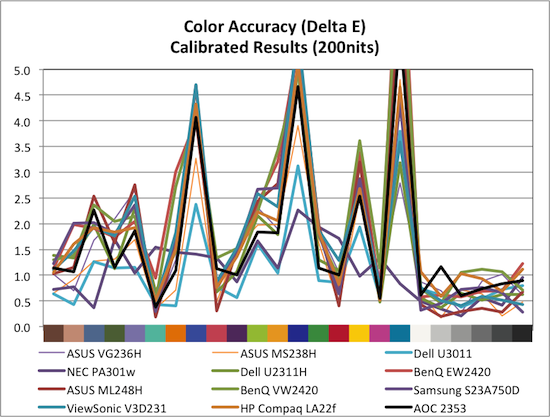
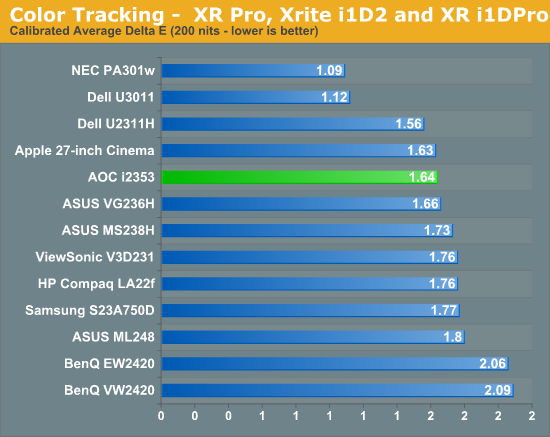
Here we see that the AOC calibrated down to an average dE of 1.64, which is pretty common. When I looked at the results some more, I got a little curious and also decided to see what the median color error was for all the displays. The Gretag Macbeth color checker includes some shades of blue that are at the very edge of the sRGB colorspace, or totally out of it in the case of one sample. In these cases if the display can’t reproduce those shades, the average dE for it might be thrown way off, but the median dE could still be very low since it does a very good job with the colors it can reproduce.
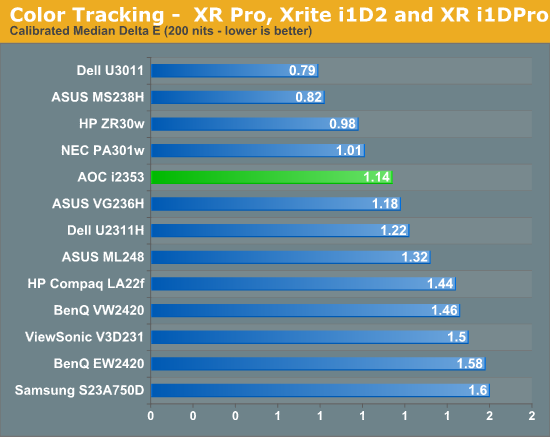
Looking at the results, we can see that the AOC has a much lower median dE than some monitors that produce a lower average dE. When we get to the color gamut data later in the review, we will see that the AOC has a smaller than average gamut, which is leading it to have larger than average errors for color samples on the edge of the sRGB colorspace. In effect, the conclusion we can pull from this is that the AOC can’t produce as many colors as other reviewed displays, but for those that it can produce it does so more accurately. Results like this are why you can’t just look at a lower dE and assume that a display will automatically be better than another display with a higher dE, as it’s just a single number that only tells part of the story.
For people that might use the AOC for press work, or prefer a dimmer display in a dark room like myself, I also calibrated the display to 100 nits of brightness and then took another set of readings.
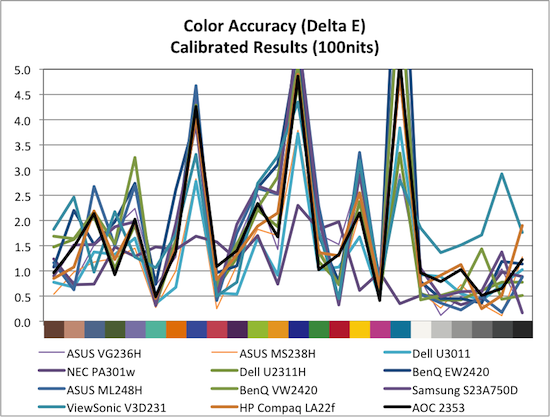
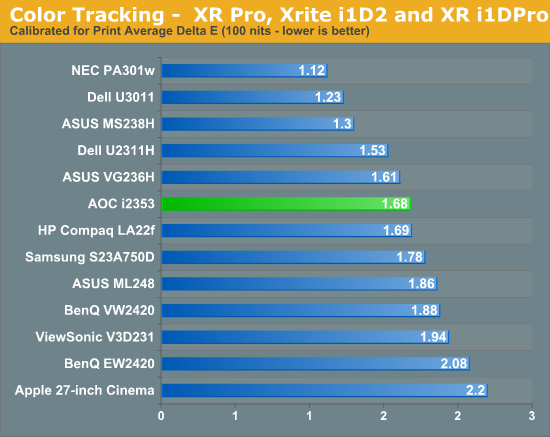
The numbers for 100 nits are almost identical to those for 200 nits. The grayscale is good, and the large errors are all contained in shades of blue, as we would expect.










71 Comments
View All Comments
VoraciousGorak - Monday, January 30, 2012 - link
My 6ms Dell 2407WFP has not only been perfectly adequate for games of any kind, I've never noticed it ghost. Ever. And I'm sensitive enough to monitor weirdness that SLI microstutter pisses me off.james.jwb - Monday, January 30, 2012 - link
I had one of these and I noticed some ghosting, but the main problem with them was input lag. You really want a screen with no more than 15ms input lag to be rid of issues. If you put a u2412m side by side with a 2407 and duplicate the desktop, you'd notice it simply by moving the mouse.The old S-PVA screens never really got input lag down to acceptable levels.
JarredWalton - Monday, January 30, 2012 - link
I've still got a 2408WFP sitting around my place, and I can definitely agree that processing lag is too high. Even my wife -- a non-techie user -- noticed it when I recently switched her to that display from an IPS panel. She thought the problem was the mouse, so I switched mice and the problem was still there. If you only ever use an S-PVA display, you may not notice what you're missing, but once you have a better reference point it becomes immediately clear that there are delays on the S-PVA panels. That said, I've never had issues with the <20ms lag; it's only when you start getting above that where it becomes noticeable (for me).JonnyDough - Monday, January 30, 2012 - link
Agreed. Input lag is also a problem. Many gamers don't seem to notice these things, but I certainly do. Maybe we were just spoiled with CRT monitors from back in the day?Sabresiberian - Monday, January 30, 2012 - link
He did.The fact is, most people wouldn't be effected by this much lag, even in FPS gaming.
That being said, if you don't pay attention to the lag from each component of your system it could all add up to something that does effect your performance, so getting a monitor with lower lag can be a plus. However, if you really want lower lag in gaming, I suggest a CRT. Of course if you demand larger than 21" you can't really do that, but then I suggest gaming lag isn't your main concern, if that's the case.
(You also pretty much have to buy used, since they aren't made anymore. However, you can find CRT monitors with better quality than LCDs for less money.)
;)
Zingam - Tuesday, January 31, 2012 - link
TN monitors are crap! I have one low end IPS display and I love it. It is perfect even for games! Oh, yeah, and I connect it to a laptop with ordinary TN display and do you know what? I hate looking at the laptop because of its crappy TN display!TN sucks! That's it! Get over it, losers!
MadAd - Wednesday, February 1, 2012 - link
Im waiting to replace my current IPS, but I wont take TN either.Why no display port too? Or 1200 lines? I want something to drop in the middle of my other 2 24" displays, so i can drive them in a big desktop, having one at 1080 is going to mess it all up.
Seems ill be waiting a long time.
eezip - Monday, January 30, 2012 - link
In the last row of the table on page 1, should the price check be 1/24/2012, instead of 2011?cheinonen - Monday, January 30, 2012 - link
Sorry, fixed!demonbug - Monday, January 30, 2012 - link
On the power use chart, do the Apple Cinema Display and Dell U3011 really use more power at min. brightness than at max, or did they just get their numbers reversed?